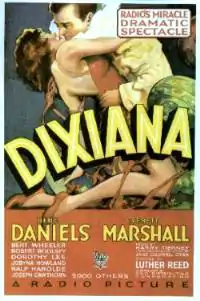Dixiana (film)
Dixiana (1930) is a lavish American pre-Code comedy, musical film directed by Luther Reed and produced and distributed by RKO Radio Pictures. The final twenty minutes of the picture were photographed in Technicolor. The film stars Bebe Daniels, Everett Marshall, Bert Wheeler, Robert Woolsey, Joseph Cawthorn, Jobyna Howland, Ralf Harolde, Bill "Bojangles" Robinson (in his film debut) and Dorothy Lee. The script was adapted by Luther Reed from a story by Anne Caldwell.
| Dixiana | |
|---|---|
 Theatrical release poster | |
| Directed by | Luther Reed Fred Fleck (assistant) |
| Written by | Anne Caldwell (story) Luther Reed (script) |
| Starring | Bebe Daniels Everett Marshall Wheeler & Woolsey Joseph Cawthorn Jobyna Howland Ralf Harolde Bill "Bojangles" Robinson Dorothy Lee |
| Music by | Victor Baravalle (direction) Max Steiner (orchestration) |
| Cinematography | J. Roy Hunt |
Production company | |
| Distributed by | RKO Radio Pictures |
Release date |
|
Running time | 100 minutes |
| Country | United States |
| Language | English |
| Budget | $747,000[2] |
| Box office | $780,000[2] |
This is the film in which composer Max Steiner received his first screen credit for orchestration. Additionally, it was Wheeler & Woolsey's third film; however, as they were not yet an official "team", they were still billed separately.
Plot
Dixiana Caldwell and her friends, Peewee and Ginger, are circus performers in the antebellum Southern United States. When Dixiana falls in love with a young Southern aristocrat, Carl Van Horn, she leaves the circus where she is employed and, with Peewee and Ginger, accompanies Carl to his family's plantation in order to meet Van Horn's family. At first thrilled with the news of their impending nuptials, Carl's father and stepmother, Cornelius and Birdie Van Horn, throw a lavish party for the couple. However, Peewee and Ginger inadvertently disclose Dixiana's background as a circus performer, creating a scandal for the elder Van Horns.
Asked by the stepmother to leave in disgrace, Dixiana and her friends return to New Orleans, seeking to gain re-employment from her former employer at the Cayetano Circus Theatre, but they are regretfully refused by him, due to the way she had departed. Desperate, she takes employment at a local gambling hall, run by Royal Montague, who also has personal designs on Dixiana. As part of his plan, he intends to financially ruin Carl and his family and use Dixiana to accomplish that purpose.
Things come to a head when Dixiana is crowned queen of the Mardi Gras. When Montague absconds with her, Carl challenges him to a duel, but, when a disguised Dixiana shows up in his stead, she tricks Montague into revealing his nefarious plans. Carl and Dixiana are reunited.[3]
Cast
- Bebe Daniels as Dixiana Caldwell
- Everett Marshall as Carl Van Horn
- Bert Wheeler as Peewee
- Robert Woolsey as Ginger Dandy
- Joseph Cawthorn as Cornelius Van Horn
- Jobyna Howland as Birdie Van Horn
- Dorothy Lee as Poppy
- Ralf Harolde as Royal Montague
- Edward Chandler as Blondell
- George Herman as Contortionist
- Raymond Maurel as Cayetano
- Bruce Covington as Company porter
- Bill Robinson as 'Bojangles' - Tap Dancer
- Eugene Jackson as Cupid
(Cast list as per AFI database)[1]
Copyright status
At the end of 1958, the film entered the public domain in the United States because RKO did not renew its copyright registration in the 28th year after publication.[4]
Preservation status
The Technicolor sequences were considered lost for years but were re-discovered in 1988 and subsequently included in the restored DVD.
Reception
Reviewer Mordaunt Hall of The New York Times wrote of the singing, "...one wishes there was more of it and less of the somewhat futile attempt at a story" and noted that Bill Robinson "...gives an excellent exhibition of tap dancing, which won a genuine round of applause" and concluded, "The early glimpses of the circus theatre ... lead one to expect more than one is apt to get out of this production."[5]
The film reunited the director and most of the cast of RKO's most successful film of the year before, Rio Rita, but lackluster performances and direction, as well as a glut of movie musicals led to the film being one of RKO's biggest disappointments of 1930. The film lost an estimated $300,000.[2][6]
References
- "Dixiana: Detail View". American Film Institute. Archived from the original on August 6, 2014. Retrieved September 20, 2016.
- Richard Jewel, 'RKO Film Grosses: 1931-1951', Historical Journal of Film Radio and Television, Vol 14 No 1, 1994 p57
- Bradley, Edwin M. (January 1, 2004). "Chapter 7: 1929-1930". The First Hollywood Musicals: A Critical Filmography of 171 Features, 1927 through 1932. Jefferson, North Carolina: McFarland & Company. pp. 192–195. ISBN 9780786420292. Retrieved February 8, 2015.
- Pierce, David (June 2007). "Forgotten Faces: Why Some of Our Cinema Heritage Is Part of the Public Domain". Film History: An International Journal. 19 (2): 125–43. doi:10.2979/FIL.2007.19.2.125. ISSN 0892-2160. JSTOR 25165419. OCLC 15122313. S2CID 191633078.
- Mordaunt Hall (September 5, 1930). "The Screen: Dixiana (1930)". The New York Times.
- Jewell, Richard B.; Harbin, Vernon (1982). The RKO Story. New York: Arlington House. p. 29. ISBN 0-517-546566.
External links
| Wikimedia Commons has media related to Dixiana. |